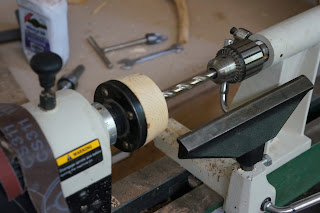Here is a quick tutorial on setting up to turn pens on the lathe. This is a good exercise to lead students beyond turning simple spindles where some degree of success is almost certain. To turn something as thin as a pen takes much greater skill. All of my 7th, 8th and 9th grade students broke one or more turning blanks before they successfully made a pen. Expecting some failures, I made lots of blanks from walnut and cherry so they could experience a choice of woods. Ripped from 4/4 hardwood stock the pen blanks are extremely cheap to make using a table saw to re-saw the stock.
 |
| Drill into the block on the face plate. |
First, mount a piece of wood on a face plate, then drill into the center with a 3/8 in. drill. I shape the block of wood on the lathe to prevent it from having any sharp corners that would injure the hands. Drill in about 1/2 in. or more so the pen blank will be held securely.
 |
| Chisel the hole square to fit the turning stock. |
After the hole is drilled, use a small chisel to cut the corners of the hole square, and remove the waste. You will want to get a tight fit on the turning stock, which in this case is made 3/8 in. square and 9 in. long.
 |
| Use a 7/32 in. bit to drill the end hole. |
Use a drilling guide on the drill press to drill the holes for the nib to fit. The correct size drill bit is 7/32 in. Drill to a depth of about 3/4 in. so that some length can be trimmed off while on the lathe.
 |
| The end hole nests in the tail center. |
Use a ball bearing tail center that has a center point sized to fit inside the hole drilled in the last step. The other end is placed in the square hole in the face plate. When the pen is sanded and finished, we glue a short piece of 3/16 in. dowel inside the hole with hot melt glue and then push the standard sized nib in place.
Nibs are no longer available in stationery stores like they once were, as no one seems to write with a pen, let alone one that requires real ink. I buy my nibs from old stock available on eBay. The kids love trying their hand at real writing, and you may, too. It is actually much easier to make a pen than to learn penmanship.
 |
| My students now plan to practice their cursive. |
The kids learn that things are worth trying again and again as they refine their technique and get better results. How often does that happen in purely academic pursuits?
Make, fix and create...





I had my daughter (12) try the lathe today. At first she was concerned that she didn't have the necessary strength. But once she tried it she got hooked on it and liked it a lot.
ReplyDeleteI think a pen is an excellent project to make, since it is always more fun to make something "actual" instead of just test pieces.
Thanks for showing the tutorial.
Brgds
Jonas
This is an excellent tutorial! Teaching students to turn pens is a fantastic way to build both skill and patience, and it’s inspiring to see how they learn through trial and error. The hands-on approach, combined with the historical connection to real ink pens, makes this a truly meaningful craft. It's wonderful to hear that they’re now motivated to practice their cursive—it shows the power of making something by hand!
ReplyDeleteIf you ever need high-quality walnut, cherry, or even exotic woods for your pen-turning projects, check out Exotic Wood Zone. They offer some beautiful selections that could make your students' creations even more special. Keep up the great work in fostering craftsmanship and creativity! 🖋️🪵✨